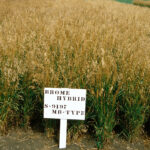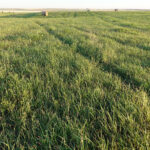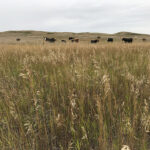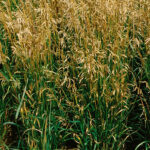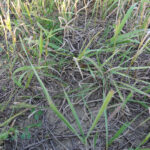Hybrid Bromegrass
Bromus inermis x Bromus riparius
General Description
Hybrid bromegrass varieties were developed in Saskatoon and released in 2000 as a slightly creeping, winter hardy, long-lived perennial forage grass. It was developed from a cross between smooth bromegrass (Bromus inermis Leyss.) and meadow bromegrass (Bromus riparius Rehm.) as a dual purpose forage for both hay and pasture systems.
Hybrid bromegrass has some characteristics like smooth bromegrass, and others like meadow bromegrass. Hybrid bromegrass has short, slowly spreading rhizomes on its roots, and is therefore less sod forming than smooth bromegrass. Hybrid bromegrass grows stems that are slightly taller than both its parents, growing upright to 100 cm (39 in). Leaves are wide, have a “W” constriction or “watermark”, and have thicker shorter hairs than meadow bromegrass. It grows basal leaves but also more leaves up the stem like smooth bromegrass.
Type
Tame grass.
Origin
Developed in Saskatoon. Hybrid cross between smooth bromegrass and meadow bromegrass.
Longevity
At least 20 years.
At least 10 years.
Use
Pasture, hay, stockpiled. Hybrid bromegrass is a dual purpose forage for both hay and pasture systems, producing a high quality, high volume first cut hay crop (like smooth bromegrass) followed by good regrowth for grazing and stockpiling (like meadow bromegrass).
Optimal Time of Use
All seasons. Hybrid bromegrass should be allowed to reach 20 to 30 cm (8 to 12 in) in height or have reached the 4 leaf stage before turn-out. Early grazed or hayed hybrid bromegrass can be grazed or stockpiled for fall, win¬ter, or spring grazing. Time grazing to allow root reserves to build prior to fall. Hay hybrid bromegrass at early bloom stage for the best yield and quality.
Recovery After Use
Recovery can occur within 45-60 days. Like meadow bromegrass, the growing point on vegetative leaves is usually below the level of grazing, enabling the plant to keep growing without any pause or change in rate of growth. However, in tillers that have become reproductive, the growing points may be removed during grazing, and regrowth will be slower, having to come from auxiliary buds.
Like meadow bromegrass, the growing point on vegetative leaves is usually below the level of grazing, enabling the plant to keep growing without any pause or change in rate of growth. However, in tillers that have become reproductive, the growing points may be removed during grazing, and regrowth will be slower, having to come from auxiliary buds.
Palatability/Nutritional Value
Hybrid bromegrass is very palatable to all classes of livestock especially in the spring and early summer. This grass has low fibre content and crude protein levels of 10 to 12%. Quality of regrowth can be maintained into the fall.
Annual Precipitation min/max (mm)
350mm / 600mm
Drought Tolerance
Good drought tolerance. Like other bromegrasses, hybrid bromegrass goes dormant during severe dry periods. It regrows quickly when there is moisture again.
Flooding Tolerance
Withstands 1 to 2 weeks of spring flooding.
Winter Hardiness
Good hardiness. In the fall, the leaves of hybrid bromegrass tolerate more frost than smooth bromegrass, but less than meadow bromegrass.
Soil Texture Preference
Hybrid bromegrass is suited to all soils but prefers well drained soil.
Erosion Control
Moderate erosion control. Hybrid bromegrass has rhizomes and fiberous roots that can both stabilize soil.
Salinity Tolerance
Slight tolerance. Hybrid bromegrass salinity tolerance will be more similar to meadow bromegrass than smooth bromegrass.
Acidity Tolerance
Moderate tolerance.
Alkalinity Tolerance
Moderate tolerance.
Seeds per kg
200,000 seeds/kg (91,000 seeds/lb)
Suggested Mixtures
Mix with alfalfa, sainfoin, cicer milkvetch, red clover, or alsike clover for pasture or hay, or combine with grass species such as timothy, intermediate wheatgrass, pubescent wheatgrass or tall fescue.
Mix with alfalfa, red clover, or alsike clover for pasture or hay, or combine with grass species such as timothy, or fescues.
Ease of Establishment
Hybrid bromegrass establishes very easily with very vigorous seedlings. Similar to the other bromegrasses, seed 1.5- 2 cm (1/2 to 3/4 in) deep with good soil contact and decrease weed competition and ensure proper seeding rates to foster good establishment.
Competitiveness
Hybrid bromegrass is similar to meadow bromegrass in competitiveness (good). Hybrid bromegrass is much less invasive than smooth bromegrass when grown in mixtures and does not become sod bound quickly.
Management Considerations
Hybrid bromegrass responds well to fertilization and in a mixture with a legume. Time haying and grazing to maximize regrowth potential.
British Columbia Rangeland Seeding Manual, Saskatchewan Dryland Forage Species Adaptation Tool, USDA Plants Database, Alberta Forage Manual, Manitoba Forage Adaptation and Comparison Guide
Hybrid bromegrass is adapted to all zones in the Central Interior, including the Bunchgrass zone in southern part of the region when grown under irrigation.
Hybrid bromegrass is adapted to the Ponderosa Pine, Interior Douglas-fir and Interior Cedar-Hemlock zones, and the Bunchgrass zone when grown under irrigation.
